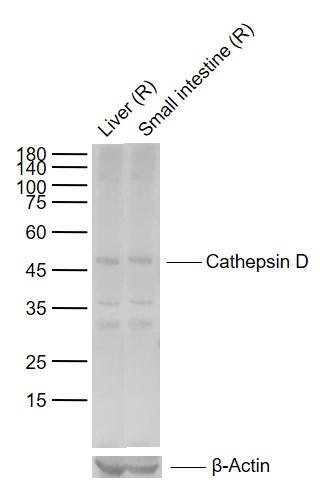
Rabbit Anti-Cathepsin D antibody
Cathepsin D light chain; CatD; CathepsinD; Cathepsin-D; CLN10; CPSD; CTSD; Lysosomal aspartyl peptidase; MGC2311; CATD_HUMAN.
View History [Clear]
Details
Product Name Cathepsin D Chinese Name 组织蛋白酶D轻链抗体 Alias Cathepsin D light chain; CatD; CathepsinD; Cathepsin-D; CLN10; CPSD; CTSD; Lysosomal aspartyl peptidase; MGC2311; CATD_HUMAN. literatures Research Area Cell biology immunology Neurobiology Synthesis and Degradation Cell adhesion molecule Extracellular matrix Immunogen Species Rabbit Clonality Polyclonal React Species Rat, (predicted: Human, Mouse, Dog, Pig, Cow, Rabbit, ) Applications WB=1:500-2000 ELISA=1:5000-10000 IHC-P=1:100-500 IHC-F=1:100-500 IF=1:100-500 (Paraffin sections need antigen repair)
not yet tested in other applications.
optimal dilutions/concentrations should be determined by the end user.Theoretical molecular weight 11/38/45kDa Cellular localization cytoplasmic Secretory protein Form Liquid Concentration 1mg/ml immunogen KLH conjugated synthetic peptide derived from human Cathepsin D light chain: 101-200/412 Lsotype IgG Purification affinity purified by Protein A Buffer Solution 0.01M TBS(pH7.4) with 1% BSA, 0.03% Proclin300 and 50% Glycerol. Storage Shipped at 4℃. Store at -20 °C for one year. Avoid repeated freeze/thaw cycles. Attention This product as supplied is intended for research use only, not for use in human, therapeutic or diagnostic applications. PubMed PubMed Product Detail Cathepsin D is a normal lysosomal protease that is expressed in all cells. It is an aspartyl protease with a pH optimum in the range of 3-5, and contains two N-linked oligosaccharides. Cathepsin D is synthesized as an inactive 52 kDa pro enzyme. Activation involves the proteolytic removal of the 43 amino acid profragment and an internal cleavage to generate the two-chain form made up of 34 and 14 kDa subunits. Cathepsin D contains the mannose-6-phosphate lysosomal localization signal that targets the enzyme to the lysosomal compartment where it functions in the normal degradation of proteins. In certain tumor cells, Cathepsin D is abnormally processed and is secreted in its 52 kDa precursor form. Numerous clinical studies as well as in vitro evidence suggest that cathepsin D plays an important role in malignant transformation and may be a useful prognostic indicator for breast cancer and possibly Alzheimer's disease.
Function:
Acid protease active in intracellular protein breakdown. Involved in the pathogenesis of several diseases such as breast cancer and possibly Alzheimer disease.
Subcellular Location:
Lysosome. Melanosome. Identified by mass spectrometry in melanosome fractions from stage I to stage IV.
Tissue Specificity:
Expressed in the aorta extrcellular space (at protein level).
Post-translational modifications:
N- and O-glycosylated.
DISEASE:
Defects in CTSD are the cause of neuronal ceroid lipofuscinosis type 10 (CLN10); also known as neuronal ceroid lipofuscinosis due to cathepsin D deficiency. A form of neuronal ceroid lipofuscinosis with onset at birth or early childhood. Neuronal ceroid lipofuscinoses are progressive neurodegenerative, lysosomal storage diseases characterized by intracellular accumulation of autofluorescent liposomal material, and clinically by seizures, dementia, visual loss, and/or cerebral atrophy.
Similarity:
Belongs to the peptidase A1 family.
SWISS:
P07339
Gene ID:
1509
Database links:Entrez Gene: 1509 Human
Entrez Gene: 13033 Mouse
Omim: 116840 Human
SwissProt: P07339 Human
SwissProt: P18242 Mouse
Unigene: 654447 Human
Unigene: 231395 Mouse
Product Picture
References (0)
No References
Bought notes(bought amounts latest0)
No one bought this product
User Comment(Total0User Comment Num)
- No comment



 +86 571 56623320
+86 571 56623320
 +86 18668110335
+86 18668110335

